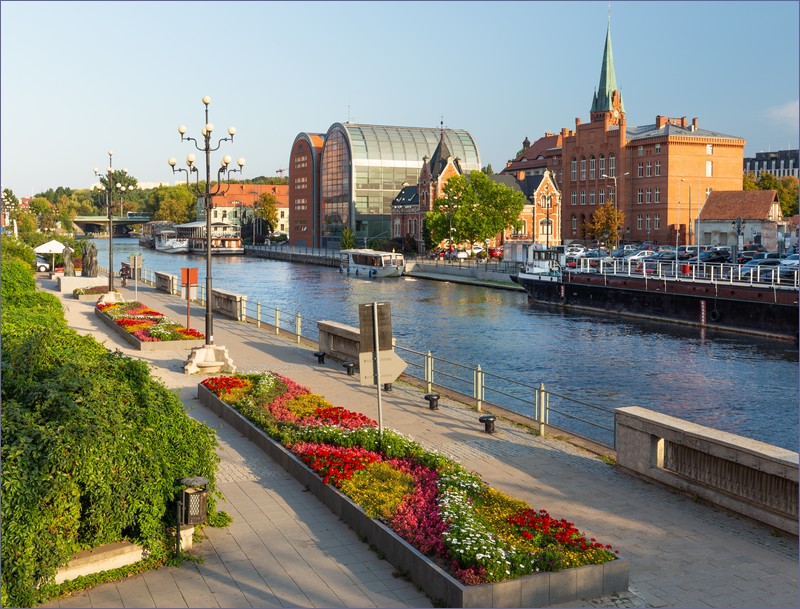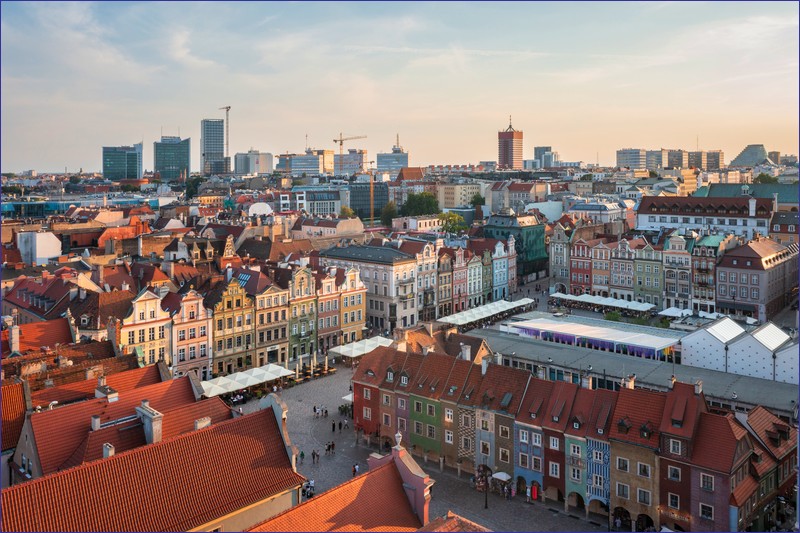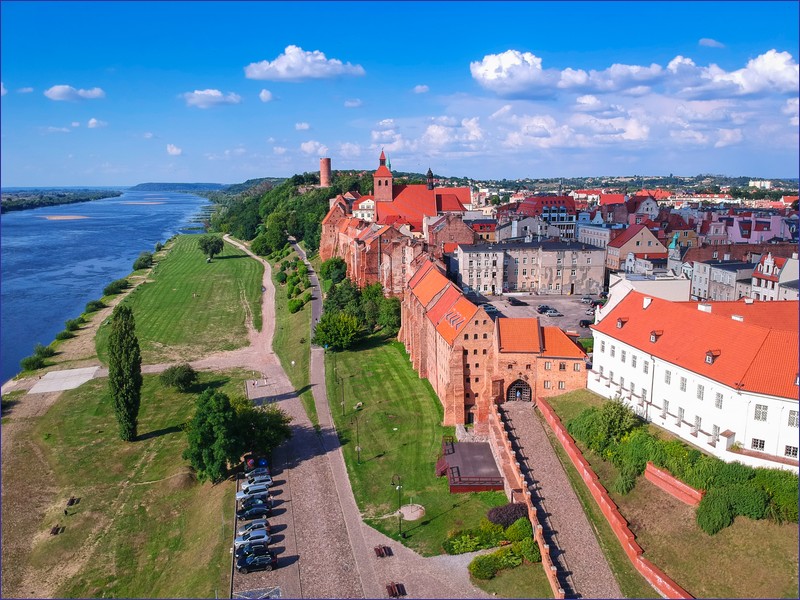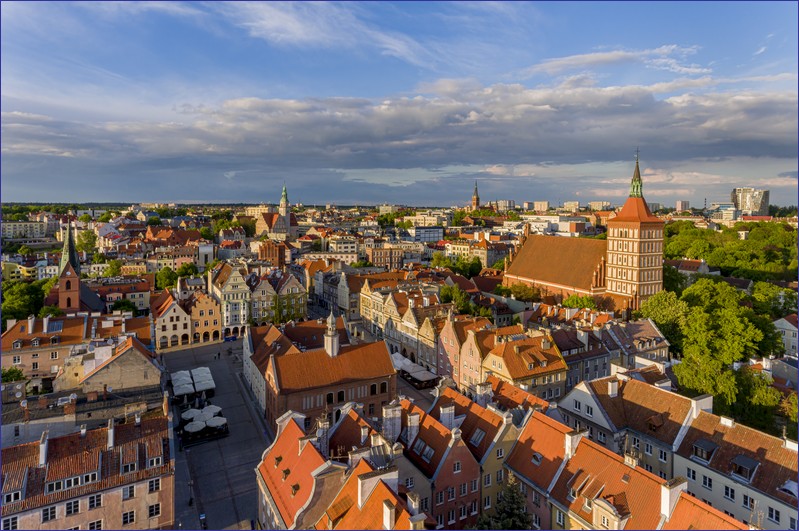Toruń is a beautiful city and also an excellent starting point for train trips. If you take a train from Toruń, you can reach many interesting places and it is to plan day trips from Toruń by train. In this article, I’ve included the most important ones that can be reached by regional trains within two hours, counting from the first to the last station within the borders of Toruń and the destination. For Olsztyn and Poznań, I would recommend using fast trains operated by PKP Intercity.
Day trips by train from Toruń – Bydgoszcz and Chojnice
Direct trains run often from Toruń to Bydgoszcz but at the Bydgoszcz Main Station you need to change trains. The route Bydgoszcz – Chojnice is served by diesel multiple units.
Bydgoszcz – a nice large city with many historical buildings. From the main train station, you can walk to the most interesting places in the city center in 15-20 minutes, or you can take a tram. The best route is undoubtedly a walk along the banks of the Brda River. Following the boulevard, you will reach Mill Island, which I consider the most beautiful spot in Bydgoszcz. Mill Island underwent revitalization, and the results are spectacular. In the summer season, the area comes to life, offering several interesting and affordable museums, as well as the famous Bydgoszcz Venice.
The rest of downtown is also appealing. The most important place is the Old Market Square, where the western frontage was demolished during the occupation, exposing the Jesuit College building. The most significant historical site is the Cathedral of St. Martin and St. Nicholas, built between 1466 and 1502. The city’s past is remembered with a model showcasing, among other things, the now-vanished Bydgoszcz Castle.
Bydgoszcz is a city of museums. The Museum of Soap and History of Dirt is often highlighted in guides, but it’s worth visiting at least a few branches of the District Museum, such as the European Money Center in the former mint building with an exhibition showcasing the unique “Bydgoszcz Treasure”, the Granaries on the Brda (exhibitions about the history and life in interwar Bydgoszcz), and the archaeological collections. Art lovers should visit the Leon Wyczółkowski House. Outside the District Museum, you’ll also find the Waterworks Museum (one branch located in the renovated water tower) and the Museum of the Polish Army. Recently, the Swan Pharmacy Museum and the Bydgoszcz Canal Museum have been added to the city’s museum scene. Bydgoszcz offers many other attractions (including the Exploseum and Myślęcinek Park), but one day is definitely not enough.
Tuchola (optional) – a holiday town located by a lake. There’s not much to see in Tuchola itself apart from the town square, but the city serves as a good base for hiking trips in the Tuchola Forest. The town also has a small Tuchola Forest Museum.
Chojnice – a lesser-known city with a charming town center located about one and a half kilometers from the train station. Some building façades feature decorative plant and animal motifs. The Historical and Ethnographic Museum is housed in the Człuchów Gate and a few other remaining elements of the old fortifications. Among the religious monuments, the most notable are the Basilica of the Beheading of St. John the Baptist, built in the mid-14th century, and the neighboring Church of the Annunciation of the Blessed Virgin Mary. In the summer, a local bus can take you to Lake Charzykowskie. Historic train station was recently renovated.
Just fifteen minutes away by bus or train (though there are very few trains) lies Człuchów. You can stop by briefly to visit the Regional Museum located in the remnants of the old castle or relax by the lake.

Direction Poznań
Destinations in Greater Poland are very popular day trips by train from Toruń. Poznań is a must-see if you visit Poland, Gniezno is very important city for Polish history. If you travel from Toruń to Poznań it is recommended to take a fast train.
Inowrocław (optional) – a spa town, not particularly remarkable in terms of city center architecture. If you decide to visit Inowrocław, you should take advantage of the two saline parks and the local thermal baths. The distance from the train station to the parks is quite considerable. It’s also worth noting the walls of the Church of the Blessed Virgin Mary (built between 1180 and the early 13th century), where mysterious masks and images of beasts can be painted or carved.
Gniezno – the first capital of Poland, with numerous religious monuments, the most important of which is the cathedral with a viewing tower open to the public. It’s also worth visiting the Museum of the Origins of the Polish State. A recently established “rabbit trail” guides visitors between main attractions in the city centre. Railway enthusiasts should visit the local roundhouse, and during summer season, on weekends, you can take a ride on the short route that remains from the once-thriving Gniezno Narrow-Gauge Railway. The city center and major attractions are within walking distance from the train station.
Pobiedziska (optional) – there are several interesting tourist attractions for everyone not far from the renovated railway station. The most important attraction is the Miniature Park in Pobiedziska, featuring miniature replicas of characteristic buildings from Greater Poland. Families with children enjoy spending time in the wooden settlement, where you can visit an exhibition of full-scale medieval siege machines, an armory, and a shooting range, and enjoy outdoor games.
From the stations Kocanowo and Fałkowo, located between Pobiedziska and Gniezno, you can walk or cycle to the open-air museum in Dziekanowice and Lake Lednica.
Poznań – the capital of the Greater Poland region, offering many interesting attractions. The main train station, Poznań Główny, is located close to the city center and its main sights. A one-day sightseeing plan can include a walk from the main station to the Old Town Square (one way via the bus terminal, and the return via Święty Marcin Street; with a stop at the Stary Browar shopping and arts center along the way), a visit to the Collegiate Basilica near the market square with its beautiful interiors, followed by a trip to Ostrów Tumski (featuring the cathedral and the famous 3D mural in the Śródka neighborhood), and optionally a walk by Lake Malta. In the high season, you can also ride the narrow-gauge Maltanka train, operated by MPK Poznań.
If you have enough time, you can visit one of the many museums in the city center. Currently, the most popular is Brama Poznania, which features archaeological exhibits. The Enigma Cipher Center on Święty Marcin Street is especially popular among young people, while adults can choose from several branches of the National Museum in Poznań, depending on their interests.

Day trips from Toruń by train – Grudziadz and Kwidzyn
A day trip by local trains. Trains from Toruń end at Grudziadz train station (very ugly) where you need to change trains and continue your journey to Kwidzyn. Toruń – Grudziądz is a local railway line served by diesel multiple units. You can plan for example day trip Toruń – Grudziądz – Bydgoszcz – Toruń.
Chełmża (optional) – a neglected town, known for its lake, which in the summer attracts residents of the Kuyavian-Pomeranian Voivodeship looking to relax. The lake, which is 6 kilometers long and covers an area of 300 hectares, reaches a depth of 27 meters. You can rent water sports equipment or take a walk along a 360-meter-long wooden pier built in 2014. The historic sites are spread over a small area. The heart of the town is the market square, where the town hall stands — built between 1897 and 1900 on the site of a former tenement house. The most valuable religious monument is the Co-Cathedral Basilica of the Holy Trinity, constructed between 1251 and 1359, and visited many times by Polish kings. Right next to the co-cathedral is a 14th-century stone gate. Also worth noting is the Gothic Church of St. Nicholas, dating back to the mid-13th century.
Grudziądz – a somewhat depressing and neglected city, but worth visiting for its historical monuments and tram network. The most important landmarks are the ensemble of historic granaries located on the Vistula escarpment. These granaries, which form a beautiful panorama, were repeatedly damaged by fires and wars over the centuries. The oldest dates back to 1346–1351. Today, they house the Fr. Władysław Łęga Museum. Branches of the museum are also located in the former Benedictine Abbey complex and in the Klimek Tower — a remnant of the old castle, now adapted as a viewing tower. A portion of the old city walls has been preserved. Among religious buildings, the Church of St. Nicholas, the Jesuit College, and the Church of St. Francis Xavier are notable.
Kwidzyn – the city’s landmark is the Castle of the Pomesanian Chapter, probably built between 1320 and 1345. The castle now hosts a branch of the Malbork Castle Museum. The castle is connected to a cathedral, which can be toured with a guide (reviews are mixed). Among the historic buildings, the railway station building is also worth mentioning.

Direction – Sierpc
The railway line from Toruń to Sierpc was for a long time at risk of having passenger services discontinued, and train operations were suspended for an extended period. The largest town between Toruń and Sierpc is Lipno, but in terms of tourism, it’s hard to find anything particularly special there. Since the market square was paved over, it has lost much of its charm. However, with a bit of luck, it’s possible to find inexpensive accommodation in the area.
Skępe – the most interesting place on the Toruń–Sierpc route. This town is picturesquely situated among lakes, featuring a historic Benedictine monastery complex on the border between Skępe and Wymyślin. It’s a place rich in history and intriguing legends, and home to the miraculous image of Our Lady of Skępe. It serves as a center for pilgrimages.
Sierpc – known for its large and well-maintained open-air museum, the Museum of the Mazovian Countryside. The town has also preserved the Gothic parish church of St. Vitus and a former Orthodox church, which now houses a courthouse. The train station, built in a manor house style, was recently renovated.
Day trips from Toruń by train – direction Olsztyn
If you’re planning a trip from Toruń to Olsztyn, an express train is the better choice – it’s faster and more comfortable. Olsztyn is also a good weekend destination, though its main attractions can easily be visited in an one day.
Wąbrzeźno (optional) – a town you can visit, but you can also skip. The town center is about 3 kilometers from the train station. It’s of particular interest to railway enthusiasts, as it used to be possible to travel from the station to the center on what was probably the shortest scheduled passenger railway line in Poland. In memory of that, the old town station was reconstructed and a short stretch of track preserved. Other attractions include sacred monuments: the Church of Saints Simon and Jude Thaddeus (mid-14th century) and a former Evangelical church from the 1830s. A positive highlight is the revitalized and nicely developed area around Lake Zamkowe.
Brodnica (optional) – formerly an important railway junction. When traveling from Toruń, a transfer at Jabłonowo Pomorskie is required. The town’s landmark is a tower remaining from the former Teutonic castle, now home to the Brodnica Museum. From the top of the 54-meter tower, you can enjoy a panoramic view of the town. Another museum branch is located in the Chełmińska Gate and its adjacent townhouse. The Environmental Education Center, housed in a historic granary, showcases the flora and fauna of the Brodnica Lake District and includes a reconstructed Mesolithic hunter settlement discovered in Mszano. Entrance tickets to all museum branches are very affordable.
Iława (optional) – a beautiful railway station and popular lake. The town lies on the shores of Lake Jeziorak, the longest lake in Poland, which makes it a popular destination for sailing, water sports, and summer relaxation. Most important landmarks are the Neo-Gothic Town Hall and the historic Church of the Transfiguration. Iława is also known for the nearby Iława Lake District Landscape Park, offering beautiful natural scenery and hiking opportunities.
Ostróda – a picturesque town on a lake, surrounded by pedestrian and bike paths as well as a range of seasonal attractions. Ostróda is the starting or ending point of the famous canal connecting it to Elbląg. A small historical museum operates in the former Teutonic castle. Near the train station is the Church of the Immaculate Conception, and the complex of former military barracks is also worth seeing.
Olsztyn – the capital of the Warmian-Masurian Voivodeship, and an interesting destination for both short and longer trips. At the time of writing, a new main railway station, Olsztyn Główny, was under construction. It is about 2 kilometers from the city center, so it’s better to get off at Olsztyn Zachodni station. Almost the entire historic city center was destroyed by the Red Army during World War II. Some buildings were rebuilt. Original structures that survived include the 14th-century Castle of the Warmian Chapter, now home to the Museum of Warmia and Masuria, and the co-cathedral basilica of St. James.
The Museum of Warmia and Masuria also operates two other interesting branches in Olsztyn: the Natural History Museum in a historic manor house, and the “Gazeta Olsztyńska” House in a renovated former printworks. The latter tells the story of Olsztyn, its people, and the activities of the “Gazeta Olsztyńska” newspaper. In the former sawmill building, you’ll find the Center for Technology and Regional Development – Museum of Modernity, with exhibits on the development of Olsztyn and the surrounding region. You can also visit an astronomical observatory. In summer, there are many opportunities for active recreation around the lakes.
Related articles:
Train travel in Poland – a comprehensive guide
